Feds: Delays worsened spill
Exxon faulted for response to 2011 oil pipeline rupture

BILLINGS – Delays in Exxon Mobil Corp.’s response to a major pipeline break beneath Montana’s Yellowstone River made an oil spill far worse than it otherwise would have been, federal regulators said in a new report.
The July 2011 rupture fouled 70 miles of riverbank along the scenic Yellowstone, killing fish and wildlife and prompting a massive, monthslong cleanup.
The damage could have been significantly reduced if pipeline controllers had acted more quickly, according to Department of Transportation investigators.
The report, provided to the Associated Press by the office of Montana U.S. Sen. Max Baucus, marks the first time federal regulators have highlighted specific actions by Exxon as contributing to the severity of the spill.
An Exxon spokeswoman said Wednesday the company was reviewing the findings.
The spill released about 63,000 gallons of crude from Exxon’s 20-year-old Silvertip pipeline into the river near the city of Laurel. That damage would have been reduced by about two-thirds if controllers in Houston isolated the rupture as soon as problems emerged, investigators said.
Instead, after Exxon personnel partially shut down the line and were weighing their next steps, crude drained from the severed, 12-inch pipeline for another 46 minutes before a key control valve was finally closed.
Exxon spent $135 million on its response to the spill, including cleanup and repair work.
Spokeswoman Rachael Moore said the company will continue to cooperate with the Pipeline and Hazardous Materials Safety Administration and “is committed to learning from these events.”
The report chalks up the immediate cause of the spill to floodwaters that damaged the pipeline and left it exposed. Debris washing downriver piled up on the line, increasing pressure until it ruptured.
The “volume would have been much less” and the location of spill “would have been identified far more quickly” if Exxon’s emergency procedures had called for the immediate closure of upstream valves, investigators said.
The report also faulted Exxon for lacking a plan to notify pipeline controllers that the river was flooding.
Exxon workers were not blamed, however, for steps taken in the lead-up to the spill.
Exxon’s field observations and “depth of cover survey took reasonable precautions to address the flooding of the Yellowstone River in the spring and early summer of 2011,” the investigators wrote.
City officials in Laurel had warned Exxon that the riverbank was eroding. The company, however, continued to run crude beneath the Yellowstone after finding that a section of pipeline leading away from the river was still buried more than 6 feet deep.
The report did not address concerns raised by Baucus, a Democrat, and other lawmakers over whether existing pipeline regulations do enough to prevent spills at river crossings.
Under current rules, companies must bury pipelines 4 feet beneath a riverbed and inspect them periodically.
Those rules are being reviewed, and Baucus said Wednesday that “transparency and oversight are critical to making sure we never have to go through the devastation of the Yellowstone River oil spill again.”
Landowners along the river have sued Exxon, saying the company didn’t do enough to prevent the spill and should have shut down the line during flooding. Exxon is fighting the lawsuits.
An attorney for plaintiffs in one of the cases, Jory Ruggiero, said Wednesday that Exxon at a minimum should have been on high alert when the pipeline broke and ready to shut it down instantly.
But federal officials also bear some responsibility, said Carl Weimer with the Pipeline Safety Trust, an advocacy group. He said government officials were in a position to review the company’s accident response plans prior to the accident and make sure those were sufficient.
The federal investigation into the spill remains open. Whether any citations will be issued is under review, said spokesman Damon Hill with the Department of Transportation’s Pipeline and Hazardous Materials Safety Administration.
No timetable was available for any such decision, Hill added.